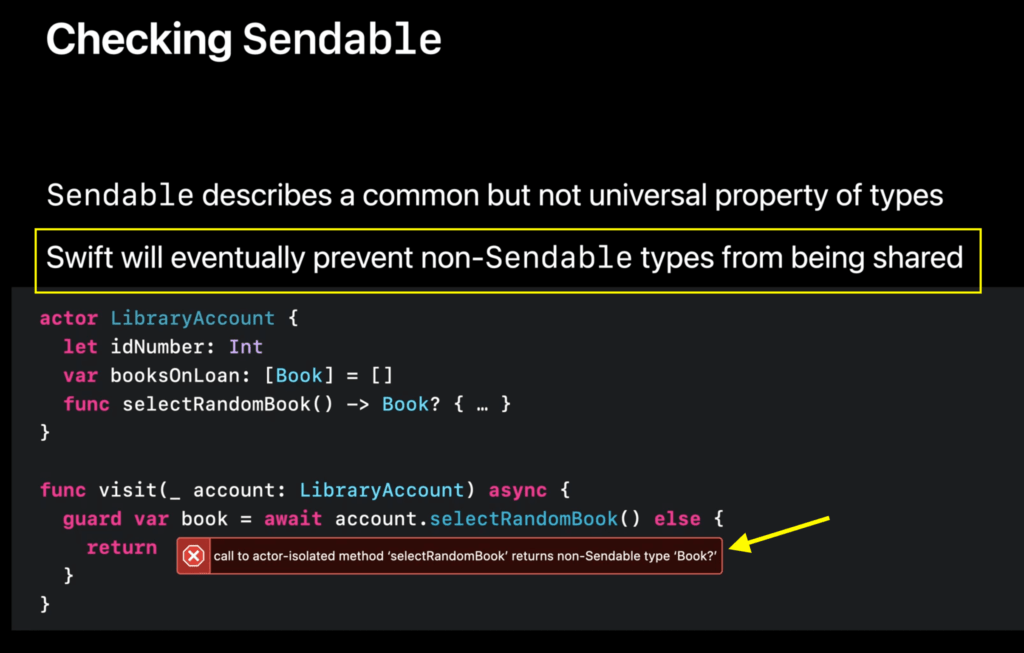本文是 『 Swift 新并发框架 』系列文章的第三篇,主要介绍 Swift 5.6 引入的 Sendable。
©原创文章,转载请注明出处!
本系列文章对 Swift 新并发框架中涉及的内容逐个进行介绍,内容如下:
Swift 新并发框架之 Sendable
Overview
书接前文 (『 Swift 新并发框架之 actor 』),本文主要介绍 Sendable 为何物以及如何解决前文提到的那些问题。
1 | /// The Sendable protocol indicates that value of the given type can |
Sendable 是一个空协议:
用于向外界声明实现了该协议的类型在并发环境下可以安全使用,更准确的说是可以自由地跨 actor 传递。
这属于一种 『 语义 』上的要求。
像 Sendable 这样的协议有一个专有名称:『 Marker Protocols 』,其具有以下特征:
具有特定的语义属性 (semantic property),且它们是编译期属性而非运行时属性。
如
Sendable的语义属性就是要求并发下可以安全地跨 actor 传递;协议体必须为空;
不能继承自 non-marker protocols (这其实是第 2 点的延伸);
不能作为类型名用于
is、as?等操作如:x is Sendable,编译报错: Marker protocol ‘Sendable’ cannot be used in a conditional cast.
不能用作泛型类型的约束,从而使某类型遵守一个 non-marker protocol,如:
1
2
3
4
5
6
7
8
9
10protocol P {
func test()
}
class A<T> {}
// Error: Conditional conformance to non-marker protocol 'P' cannot depend on conformance of 'T' to non-marker protocol 'Sendable'
extension A: P where T: Sendable {
func test() {}
}
我们知道,值语义 (Value semantics) 类型在传递时 (如作为函数参数、返回值等) 是会执行拷贝操作的,也就是它们跨 Actor 传递是安全的。故,这些类型隐式地自动遵守 Sendable 协议,如:
基础类型,
Int、String、Bool等;不含有引用类型成员的
struct;不含有引用类型关联值的
enum;所含元素类型符合
Sendable协议的集合,如:Array、Dictionary等。
当然了,所有 actor 类型也是自动遵守 Sendable 协议的。
事实上是所有 actor 都遵守了
Actor协议,而该协议继承自Sendable:
1 | (macOS 10.15, iOS 13.0, watchOS 6.0, tvOS 13.0, *) |
class 需要主动声明遵守 Sendable 协议,并有以下限制:
class 必须是
final,否则有 Warning: Non-final class ‘X’ cannot conform to ‘Sendable’; use ‘ @unchecked Sendable’class 的存储属性必须是 immutable,否则有 Warning: Stored property ‘x’ of ‘Sendable’-conforming class ‘X’ is mutable
class 的存储属性必须都遵守
Sendable协议,否则 Warning: Stored property ‘y’ of ‘Sendable’-conforming class ‘X’ has non-sendable type ‘Y’class 的祖先类 (如有) 必须遵守
Sendable协议或者是NSObject,否则 Error: ‘Sendable’ class ‘X’ cannot inherit from another class other than ‘NSObject’。
以上这些限制都很好理解,都是确保实现了 Sendable 协议的类数据安全的必要保障。
回到上面那个例子:
1 | extension AccountManager { |
很明显,要消除例子中的 Warning,只需让 User 实现 Sendable协议即可。
就本例而言,User有 2 种改造方案:
由 class 改成 struct:
1
2
3
4struct User {
var name: String
var age: Int
}手动实现
Sendable协议:1
2
3
4
5final
class User: Sendable {
let name: String
let age: Int
}
回头想想,Sendable 对实现它的 class 的要求是不是太严格了 (final、immutable property) ?!
有点过于理想,有点不切实际
从并发安全的角度说,完全可以通过传统的串行队列、锁等机制保障。
此时,可以通过 @unchecked attribute 告诉编译器不进行 Sendable 语义检查,如:
1 | // 相当于说 User 的并发安全由开发人员自行保证,不用编译器检查 |
Sendable 作为协议只能用于常规类型,对于函数、闭包等则无能为力。
此时,就轮到 @Sendable 登场了。
@Sendable
被 @Sendable 修饰的函数、闭包可以跨 actor 传递。
对于前文提到的例子:
1 | extension BankAccount { |
只需对 addAge 方法的 completion 参数加上 @Sendable 即可:
1 | func addAge(amount: Int, completion: @Sendable (User) -> Void) |
总结一下,用@Sendable 修饰 Closure 真正意味着什么?
其实是告诉 Closure 的实现者,该 Closure 可能会在并发环境下调用,请注意数据安全!
因此,如果对外提供的接口涉及 Closure (作为方法参数、返回值),且其可能在并发环境下执行,就应用 @Sendable修饰。
根据这一原则,actor 对外的方法如涉及 Closure,也应用
@Sendable修饰。
1 | extension Task where Failure == Error { |
如 Task 的 operation 闭包会在并发环境下执行,故用了 @Sendable 修饰。
当然编译器会对 @Sendable Closure 的实现进行各种合规检查:
不能捕获 actor-isolated 属性,否则 Error: Actor-isolated property ‘x’ can not be referenced from a Sendable closure;(原因也很简单,@Sendable Closure 可能会在并发环境下执行,这与 actor 串行保护数据有冲突)
如果 @Sendable 闭包是异步的 (@Sendable () async ),则不受此限制。
大家可以思考一下是为啥?
不能捕获
var变量,否则 Error: Mutation of captured var ‘x’ in concurrently-executing code;所捕获对象必须实现 Sendable 协议,否则 Warning: Capture of ‘x’ with non-sendable type ‘X’ in a
@Sendableclosure。
还记得 Swift 新并发框架之 actor 中最后那个 crash 吗:
1 | extension User { |
这个 crash 该如何 fix 呢?
可以思考一下~
1 | extension User { |
Future Improvement
Apple 在 Protect mutable state with Swift actors - WWDC21 上提到将来 Swift 编译器会禁止共享 (传递) 非 Sendable 类型的实例。

那么,本文提到的所有 Warning 都将变成 Error!
好了,关于 Sendable 就聊这么多!
小结
Sendable本身是一个 Marker Protocol,用于编译期的合规检查;所有值语义类型都自动遵守
Sendable协议;所有遵守
Sendable协议的类型都可以跨 actor 传递;@Sendable用于修饰方法、闭包;对于会在并发环境下执行的闭包都应用
@Sendable修饰。
参考资料
swift-evolution/0296-async-await.md at main · apple/swift-evolution · GitHub
swift-evolution/0304-structured-concurrency.md at main · apple/swift-evolution · GitHub
swift-evolution/0306-actors.md at main · apple/swift-evolution · GitHub
Understanding async/await in Swift • Andy Ibanez
Concurrency — The Swift Programming Language (Swift 5.6)
Connecting async/await to other Swift code | Swift by Sundell